In-depth Analysis of Canadian Political History: 1914-1945, Essay
VerifiedAdded on 2023/03/20
|8
|2101
|58
Essay
AI Summary
This essay provides an in-depth analysis of Canada's political history from 1914 to 1945, examining key events and their impacts. It explores the country's involvement in World War I and World War II, including the issues of conscription and the contributions of First Nations. The essay also delves into the social and economic transformations of the era, such as labor unrest, the Great Depression, and the changing roles of women. Using news articles and research papers as primary sources, the essay highlights the political shifts, including the rise of new parties and government responses to economic challenges. It concludes by summarizing the lasting effects of these historical events on the Canadian political landscape.
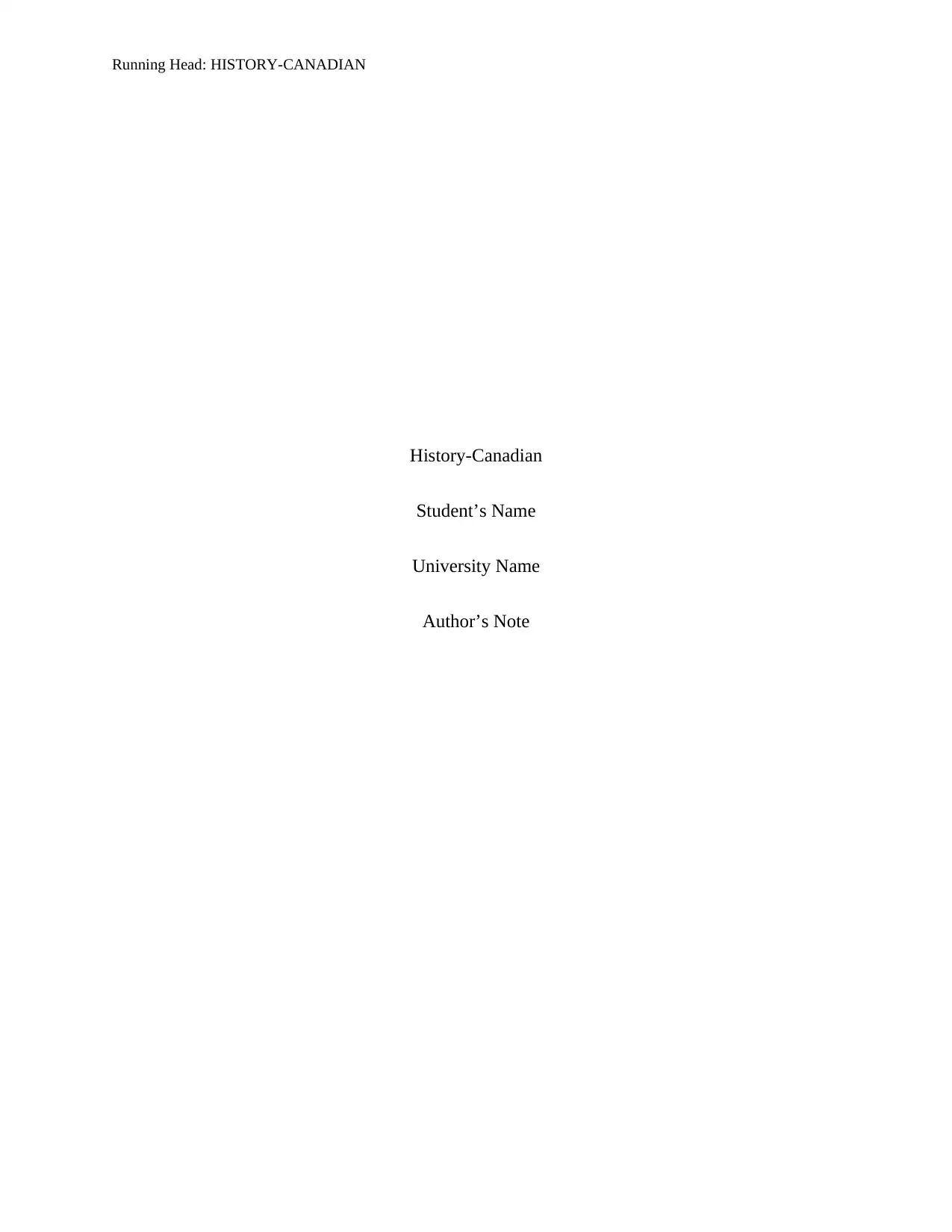
Running Head: HISTORY-CANADIAN
History-Canadian
Student’s Name
University Name
Author’s Note
History-Canadian
Student’s Name
University Name
Author’s Note
Paraphrase This Document
Need a fresh take? Get an instant paraphrase of this document with our AI Paraphraser
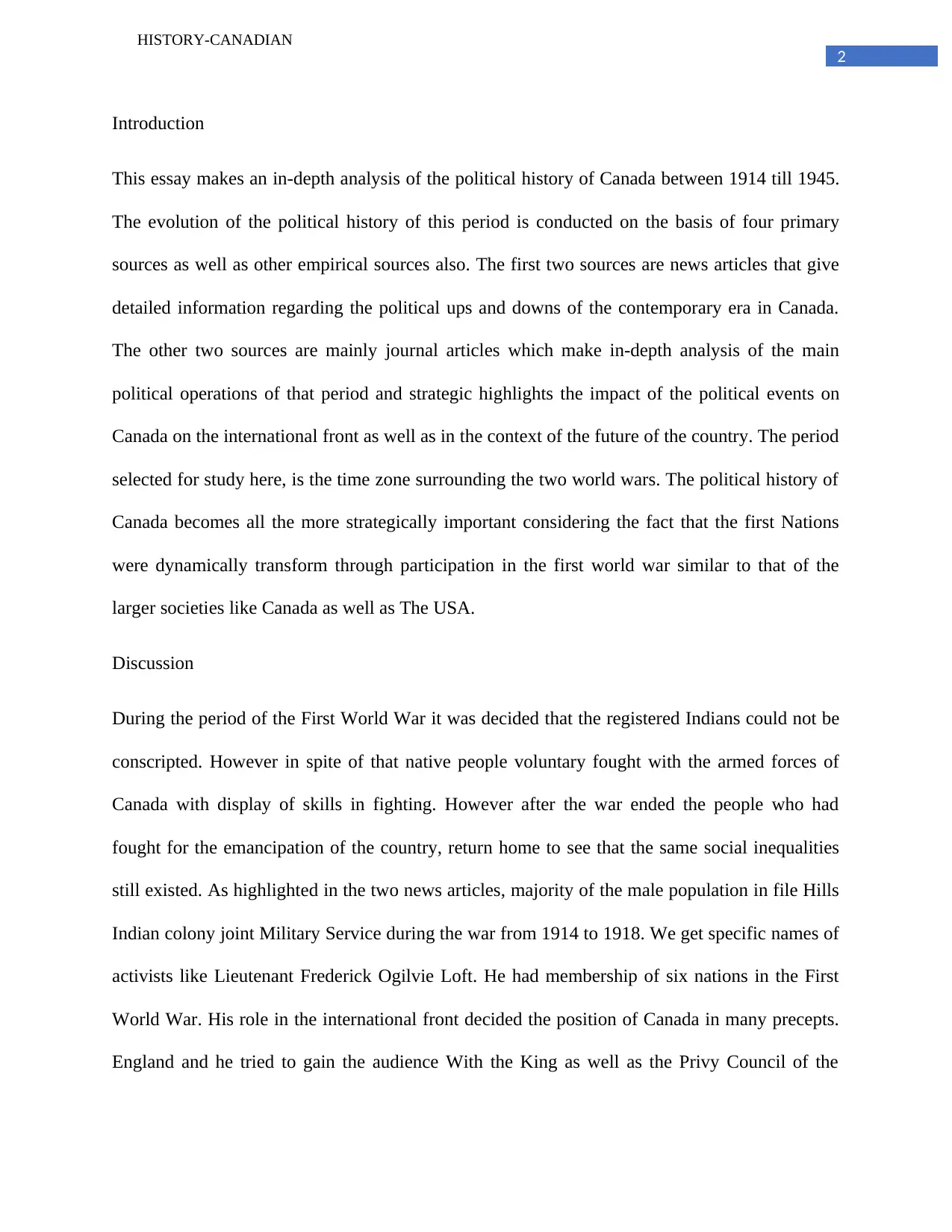
2
HISTORY-CANADIAN
Introduction
This essay makes an in-depth analysis of the political history of Canada between 1914 till 1945.
The evolution of the political history of this period is conducted on the basis of four primary
sources as well as other empirical sources also. The first two sources are news articles that give
detailed information regarding the political ups and downs of the contemporary era in Canada.
The other two sources are mainly journal articles which make in-depth analysis of the main
political operations of that period and strategic highlights the impact of the political events on
Canada on the international front as well as in the context of the future of the country. The period
selected for study here, is the time zone surrounding the two world wars. The political history of
Canada becomes all the more strategically important considering the fact that the first Nations
were dynamically transform through participation in the first world war similar to that of the
larger societies like Canada as well as The USA.
Discussion
During the period of the First World War it was decided that the registered Indians could not be
conscripted. However in spite of that native people voluntary fought with the armed forces of
Canada with display of skills in fighting. However after the war ended the people who had
fought for the emancipation of the country, return home to see that the same social inequalities
still existed. As highlighted in the two news articles, majority of the male population in file Hills
Indian colony joint Military Service during the war from 1914 to 1918. We get specific names of
activists like Lieutenant Frederick Ogilvie Loft. He had membership of six nations in the First
World War. His role in the international front decided the position of Canada in many precepts.
England and he tried to gain the audience With the King as well as the Privy Council of the
HISTORY-CANADIAN
Introduction
This essay makes an in-depth analysis of the political history of Canada between 1914 till 1945.
The evolution of the political history of this period is conducted on the basis of four primary
sources as well as other empirical sources also. The first two sources are news articles that give
detailed information regarding the political ups and downs of the contemporary era in Canada.
The other two sources are mainly journal articles which make in-depth analysis of the main
political operations of that period and strategic highlights the impact of the political events on
Canada on the international front as well as in the context of the future of the country. The period
selected for study here, is the time zone surrounding the two world wars. The political history of
Canada becomes all the more strategically important considering the fact that the first Nations
were dynamically transform through participation in the first world war similar to that of the
larger societies like Canada as well as The USA.
Discussion
During the period of the First World War it was decided that the registered Indians could not be
conscripted. However in spite of that native people voluntary fought with the armed forces of
Canada with display of skills in fighting. However after the war ended the people who had
fought for the emancipation of the country, return home to see that the same social inequalities
still existed. As highlighted in the two news articles, majority of the male population in file Hills
Indian colony joint Military Service during the war from 1914 to 1918. We get specific names of
activists like Lieutenant Frederick Ogilvie Loft. He had membership of six nations in the First
World War. His role in the international front decided the position of Canada in many precepts.
England and he tried to gain the audience With the King as well as the Privy Council of the
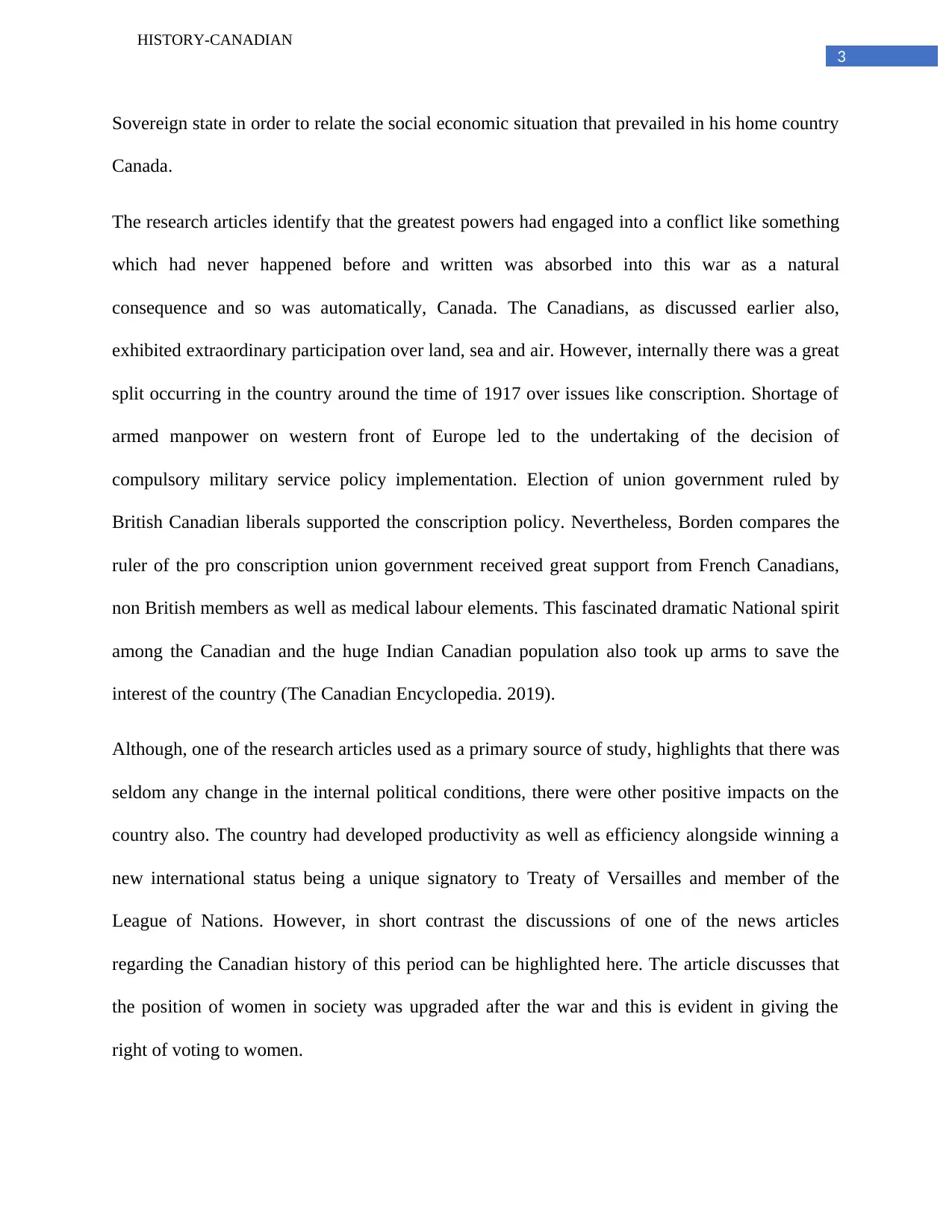
3
HISTORY-CANADIAN
Sovereign state in order to relate the social economic situation that prevailed in his home country
Canada.
The research articles identify that the greatest powers had engaged into a conflict like something
which had never happened before and written was absorbed into this war as a natural
consequence and so was automatically, Canada. The Canadians, as discussed earlier also,
exhibited extraordinary participation over land, sea and air. However, internally there was a great
split occurring in the country around the time of 1917 over issues like conscription. Shortage of
armed manpower on western front of Europe led to the undertaking of the decision of
compulsory military service policy implementation. Election of union government ruled by
British Canadian liberals supported the conscription policy. Nevertheless, Borden compares the
ruler of the pro conscription union government received great support from French Canadians,
non British members as well as medical labour elements. This fascinated dramatic National spirit
among the Canadian and the huge Indian Canadian population also took up arms to save the
interest of the country (The Canadian Encyclopedia. 2019).
Although, one of the research articles used as a primary source of study, highlights that there was
seldom any change in the internal political conditions, there were other positive impacts on the
country also. The country had developed productivity as well as efficiency alongside winning a
new international status being a unique signatory to Treaty of Versailles and member of the
League of Nations. However, in short contrast the discussions of one of the news articles
regarding the Canadian history of this period can be highlighted here. The article discusses that
the position of women in society was upgraded after the war and this is evident in giving the
right of voting to women.
HISTORY-CANADIAN
Sovereign state in order to relate the social economic situation that prevailed in his home country
Canada.
The research articles identify that the greatest powers had engaged into a conflict like something
which had never happened before and written was absorbed into this war as a natural
consequence and so was automatically, Canada. The Canadians, as discussed earlier also,
exhibited extraordinary participation over land, sea and air. However, internally there was a great
split occurring in the country around the time of 1917 over issues like conscription. Shortage of
armed manpower on western front of Europe led to the undertaking of the decision of
compulsory military service policy implementation. Election of union government ruled by
British Canadian liberals supported the conscription policy. Nevertheless, Borden compares the
ruler of the pro conscription union government received great support from French Canadians,
non British members as well as medical labour elements. This fascinated dramatic National spirit
among the Canadian and the huge Indian Canadian population also took up arms to save the
interest of the country (The Canadian Encyclopedia. 2019).
Although, one of the research articles used as a primary source of study, highlights that there was
seldom any change in the internal political conditions, there were other positive impacts on the
country also. The country had developed productivity as well as efficiency alongside winning a
new international status being a unique signatory to Treaty of Versailles and member of the
League of Nations. However, in short contrast the discussions of one of the news articles
regarding the Canadian history of this period can be highlighted here. The article discusses that
the position of women in society was upgraded after the war and this is evident in giving the
right of voting to women.
⊘ This is a preview!⊘
Do you want full access?
Subscribe today to unlock all pages.

Trusted by 1+ million students worldwide
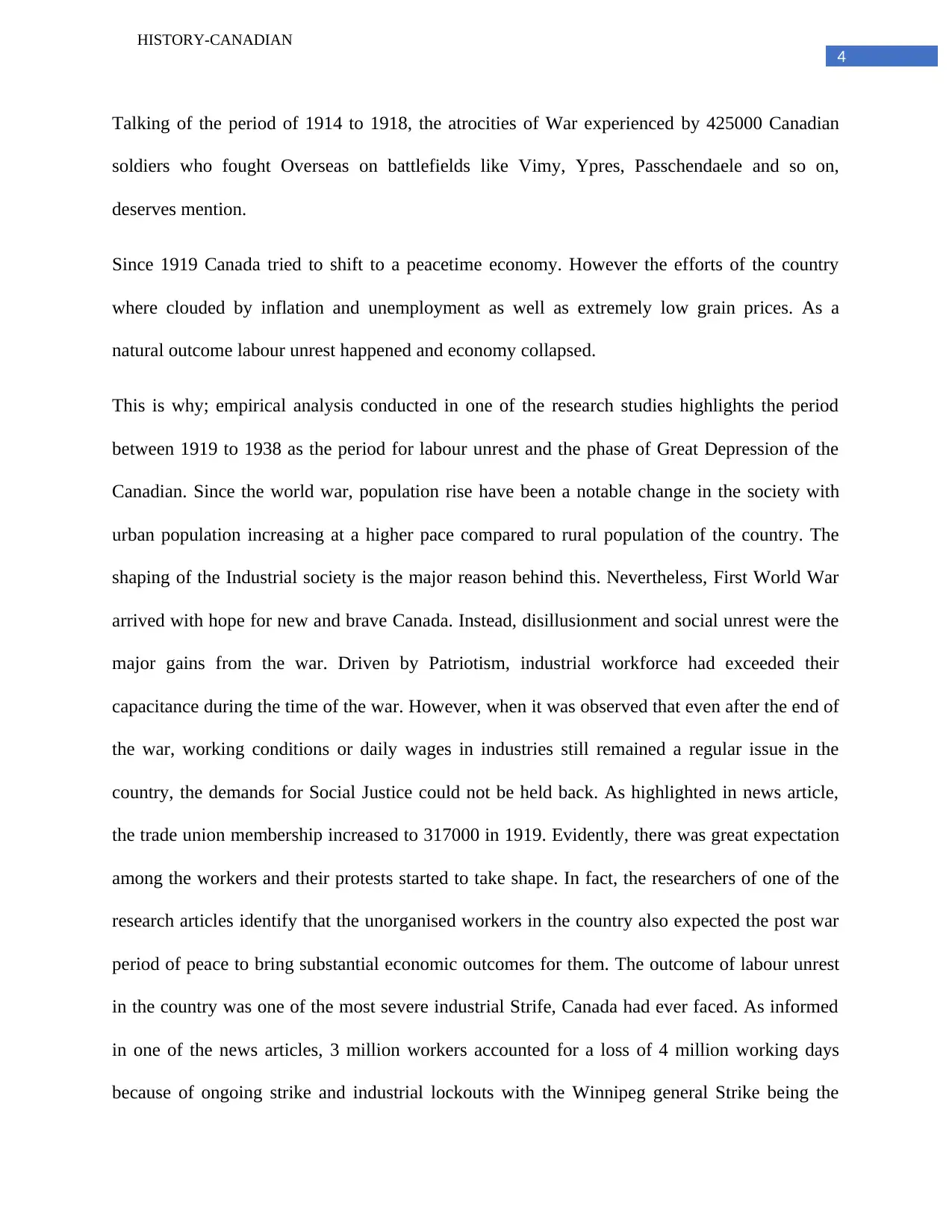
4
HISTORY-CANADIAN
Talking of the period of 1914 to 1918, the atrocities of War experienced by 425000 Canadian
soldiers who fought Overseas on battlefields like Vimy, Ypres, Passchendaele and so on,
deserves mention.
Since 1919 Canada tried to shift to a peacetime economy. However the efforts of the country
where clouded by inflation and unemployment as well as extremely low grain prices. As a
natural outcome labour unrest happened and economy collapsed.
This is why; empirical analysis conducted in one of the research studies highlights the period
between 1919 to 1938 as the period for labour unrest and the phase of Great Depression of the
Canadian. Since the world war, population rise have been a notable change in the society with
urban population increasing at a higher pace compared to rural population of the country. The
shaping of the Industrial society is the major reason behind this. Nevertheless, First World War
arrived with hope for new and brave Canada. Instead, disillusionment and social unrest were the
major gains from the war. Driven by Patriotism, industrial workforce had exceeded their
capacitance during the time of the war. However, when it was observed that even after the end of
the war, working conditions or daily wages in industries still remained a regular issue in the
country, the demands for Social Justice could not be held back. As highlighted in news article,
the trade union membership increased to 317000 in 1919. Evidently, there was great expectation
among the workers and their protests started to take shape. In fact, the researchers of one of the
research articles identify that the unorganised workers in the country also expected the post war
period of peace to bring substantial economic outcomes for them. The outcome of labour unrest
in the country was one of the most severe industrial Strife, Canada had ever faced. As informed
in one of the news articles, 3 million workers accounted for a loss of 4 million working days
because of ongoing strike and industrial lockouts with the Winnipeg general Strike being the
HISTORY-CANADIAN
Talking of the period of 1914 to 1918, the atrocities of War experienced by 425000 Canadian
soldiers who fought Overseas on battlefields like Vimy, Ypres, Passchendaele and so on,
deserves mention.
Since 1919 Canada tried to shift to a peacetime economy. However the efforts of the country
where clouded by inflation and unemployment as well as extremely low grain prices. As a
natural outcome labour unrest happened and economy collapsed.
This is why; empirical analysis conducted in one of the research studies highlights the period
between 1919 to 1938 as the period for labour unrest and the phase of Great Depression of the
Canadian. Since the world war, population rise have been a notable change in the society with
urban population increasing at a higher pace compared to rural population of the country. The
shaping of the Industrial society is the major reason behind this. Nevertheless, First World War
arrived with hope for new and brave Canada. Instead, disillusionment and social unrest were the
major gains from the war. Driven by Patriotism, industrial workforce had exceeded their
capacitance during the time of the war. However, when it was observed that even after the end of
the war, working conditions or daily wages in industries still remained a regular issue in the
country, the demands for Social Justice could not be held back. As highlighted in news article,
the trade union membership increased to 317000 in 1919. Evidently, there was great expectation
among the workers and their protests started to take shape. In fact, the researchers of one of the
research articles identify that the unorganised workers in the country also expected the post war
period of peace to bring substantial economic outcomes for them. The outcome of labour unrest
in the country was one of the most severe industrial Strife, Canada had ever faced. As informed
in one of the news articles, 3 million workers accounted for a loss of 4 million working days
because of ongoing strike and industrial lockouts with the Winnipeg general Strike being the
Paraphrase This Document
Need a fresh take? Get an instant paraphrase of this document with our AI Paraphraser
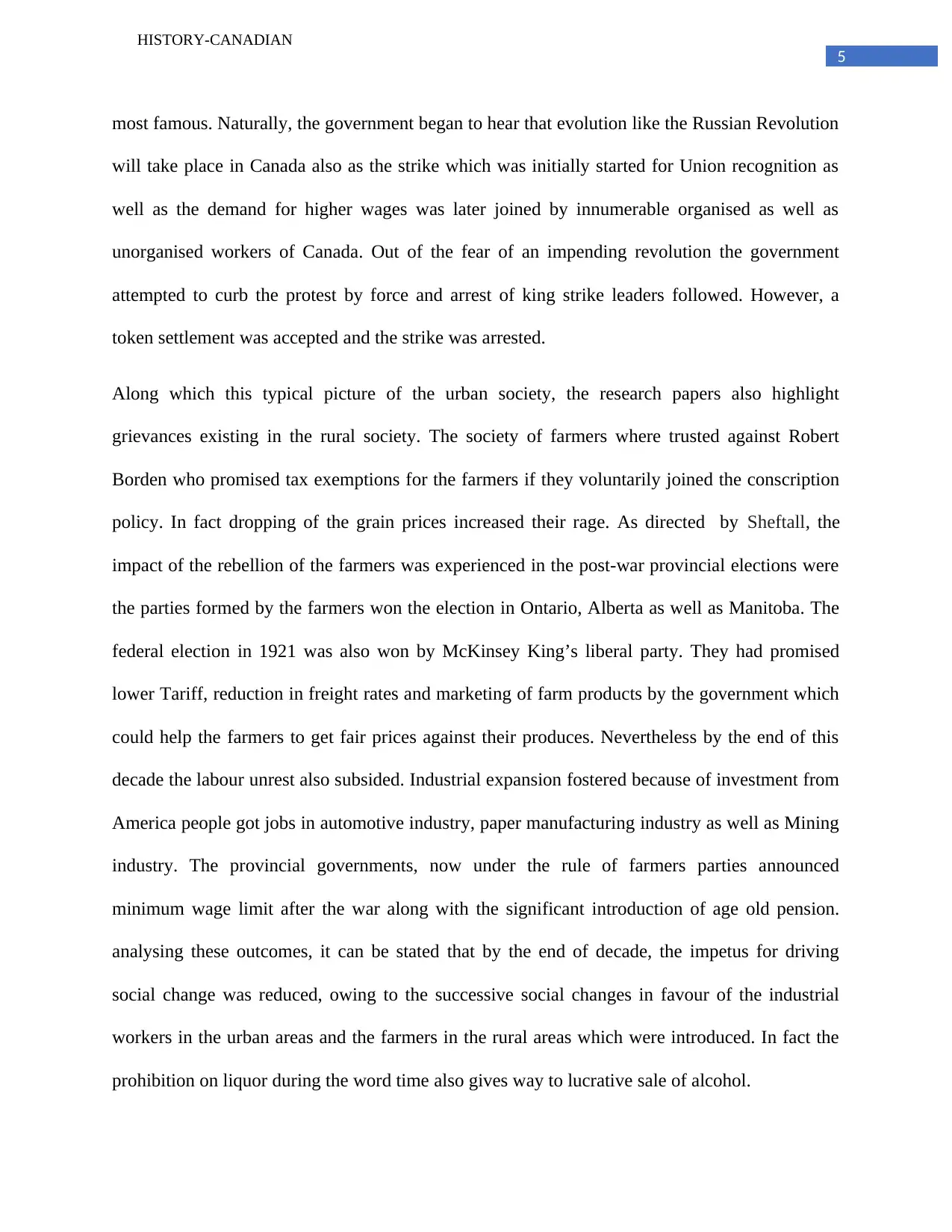
5
HISTORY-CANADIAN
most famous. Naturally, the government began to hear that evolution like the Russian Revolution
will take place in Canada also as the strike which was initially started for Union recognition as
well as the demand for higher wages was later joined by innumerable organised as well as
unorganised workers of Canada. Out of the fear of an impending revolution the government
attempted to curb the protest by force and arrest of king strike leaders followed. However, a
token settlement was accepted and the strike was arrested.
Along which this typical picture of the urban society, the research papers also highlight
grievances existing in the rural society. The society of farmers where trusted against Robert
Borden who promised tax exemptions for the farmers if they voluntarily joined the conscription
policy. In fact dropping of the grain prices increased their rage. As directed by Sheftall, the
impact of the rebellion of the farmers was experienced in the post-war provincial elections were
the parties formed by the farmers won the election in Ontario, Alberta as well as Manitoba. The
federal election in 1921 was also won by McKinsey King’s liberal party. They had promised
lower Tariff, reduction in freight rates and marketing of farm products by the government which
could help the farmers to get fair prices against their produces. Nevertheless by the end of this
decade the labour unrest also subsided. Industrial expansion fostered because of investment from
America people got jobs in automotive industry, paper manufacturing industry as well as Mining
industry. The provincial governments, now under the rule of farmers parties announced
minimum wage limit after the war along with the significant introduction of age old pension.
analysing these outcomes, it can be stated that by the end of decade, the impetus for driving
social change was reduced, owing to the successive social changes in favour of the industrial
workers in the urban areas and the farmers in the rural areas which were introduced. In fact the
prohibition on liquor during the word time also gives way to lucrative sale of alcohol.
HISTORY-CANADIAN
most famous. Naturally, the government began to hear that evolution like the Russian Revolution
will take place in Canada also as the strike which was initially started for Union recognition as
well as the demand for higher wages was later joined by innumerable organised as well as
unorganised workers of Canada. Out of the fear of an impending revolution the government
attempted to curb the protest by force and arrest of king strike leaders followed. However, a
token settlement was accepted and the strike was arrested.
Along which this typical picture of the urban society, the research papers also highlight
grievances existing in the rural society. The society of farmers where trusted against Robert
Borden who promised tax exemptions for the farmers if they voluntarily joined the conscription
policy. In fact dropping of the grain prices increased their rage. As directed by Sheftall, the
impact of the rebellion of the farmers was experienced in the post-war provincial elections were
the parties formed by the farmers won the election in Ontario, Alberta as well as Manitoba. The
federal election in 1921 was also won by McKinsey King’s liberal party. They had promised
lower Tariff, reduction in freight rates and marketing of farm products by the government which
could help the farmers to get fair prices against their produces. Nevertheless by the end of this
decade the labour unrest also subsided. Industrial expansion fostered because of investment from
America people got jobs in automotive industry, paper manufacturing industry as well as Mining
industry. The provincial governments, now under the rule of farmers parties announced
minimum wage limit after the war along with the significant introduction of age old pension.
analysing these outcomes, it can be stated that by the end of decade, the impetus for driving
social change was reduced, owing to the successive social changes in favour of the industrial
workers in the urban areas and the farmers in the rural areas which were introduced. In fact the
prohibition on liquor during the word time also gives way to lucrative sale of alcohol.
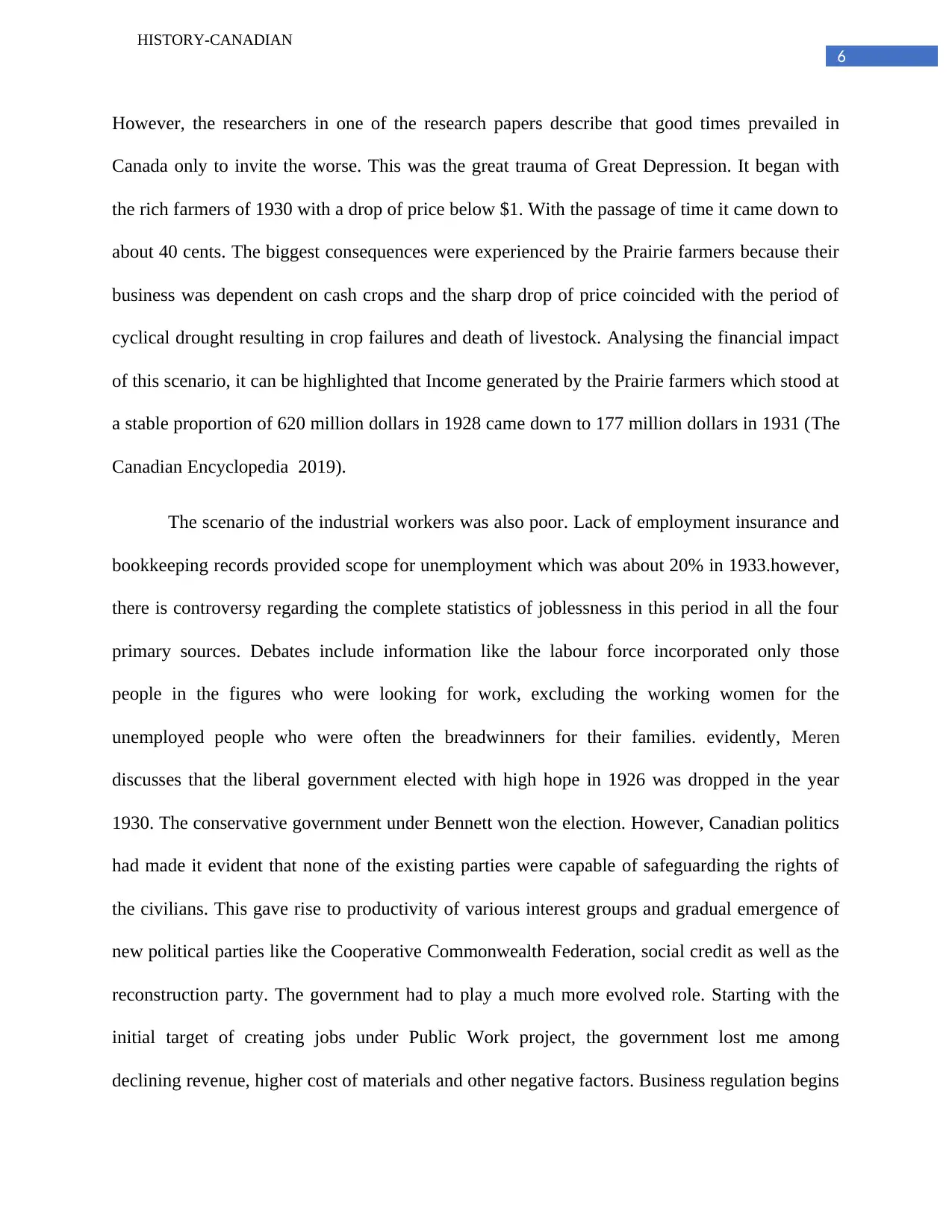
6
HISTORY-CANADIAN
However, the researchers in one of the research papers describe that good times prevailed in
Canada only to invite the worse. This was the great trauma of Great Depression. It began with
the rich farmers of 1930 with a drop of price below $1. With the passage of time it came down to
about 40 cents. The biggest consequences were experienced by the Prairie farmers because their
business was dependent on cash crops and the sharp drop of price coincided with the period of
cyclical drought resulting in crop failures and death of livestock. Analysing the financial impact
of this scenario, it can be highlighted that Income generated by the Prairie farmers which stood at
a stable proportion of 620 million dollars in 1928 came down to 177 million dollars in 1931 (The
Canadian Encyclopedia 2019).
The scenario of the industrial workers was also poor. Lack of employment insurance and
bookkeeping records provided scope for unemployment which was about 20% in 1933.however,
there is controversy regarding the complete statistics of joblessness in this period in all the four
primary sources. Debates include information like the labour force incorporated only those
people in the figures who were looking for work, excluding the working women for the
unemployed people who were often the breadwinners for their families. evidently, Meren
discusses that the liberal government elected with high hope in 1926 was dropped in the year
1930. The conservative government under Bennett won the election. However, Canadian politics
had made it evident that none of the existing parties were capable of safeguarding the rights of
the civilians. This gave rise to productivity of various interest groups and gradual emergence of
new political parties like the Cooperative Commonwealth Federation, social credit as well as the
reconstruction party. The government had to play a much more evolved role. Starting with the
initial target of creating jobs under Public Work project, the government lost me among
declining revenue, higher cost of materials and other negative factors. Business regulation begins
HISTORY-CANADIAN
However, the researchers in one of the research papers describe that good times prevailed in
Canada only to invite the worse. This was the great trauma of Great Depression. It began with
the rich farmers of 1930 with a drop of price below $1. With the passage of time it came down to
about 40 cents. The biggest consequences were experienced by the Prairie farmers because their
business was dependent on cash crops and the sharp drop of price coincided with the period of
cyclical drought resulting in crop failures and death of livestock. Analysing the financial impact
of this scenario, it can be highlighted that Income generated by the Prairie farmers which stood at
a stable proportion of 620 million dollars in 1928 came down to 177 million dollars in 1931 (The
Canadian Encyclopedia 2019).
The scenario of the industrial workers was also poor. Lack of employment insurance and
bookkeeping records provided scope for unemployment which was about 20% in 1933.however,
there is controversy regarding the complete statistics of joblessness in this period in all the four
primary sources. Debates include information like the labour force incorporated only those
people in the figures who were looking for work, excluding the working women for the
unemployed people who were often the breadwinners for their families. evidently, Meren
discusses that the liberal government elected with high hope in 1926 was dropped in the year
1930. The conservative government under Bennett won the election. However, Canadian politics
had made it evident that none of the existing parties were capable of safeguarding the rights of
the civilians. This gave rise to productivity of various interest groups and gradual emergence of
new political parties like the Cooperative Commonwealth Federation, social credit as well as the
reconstruction party. The government had to play a much more evolved role. Starting with the
initial target of creating jobs under Public Work project, the government lost me among
declining revenue, higher cost of materials and other negative factors. Business regulation begins
⊘ This is a preview!⊘
Do you want full access?
Subscribe today to unlock all pages.

Trusted by 1+ million students worldwide
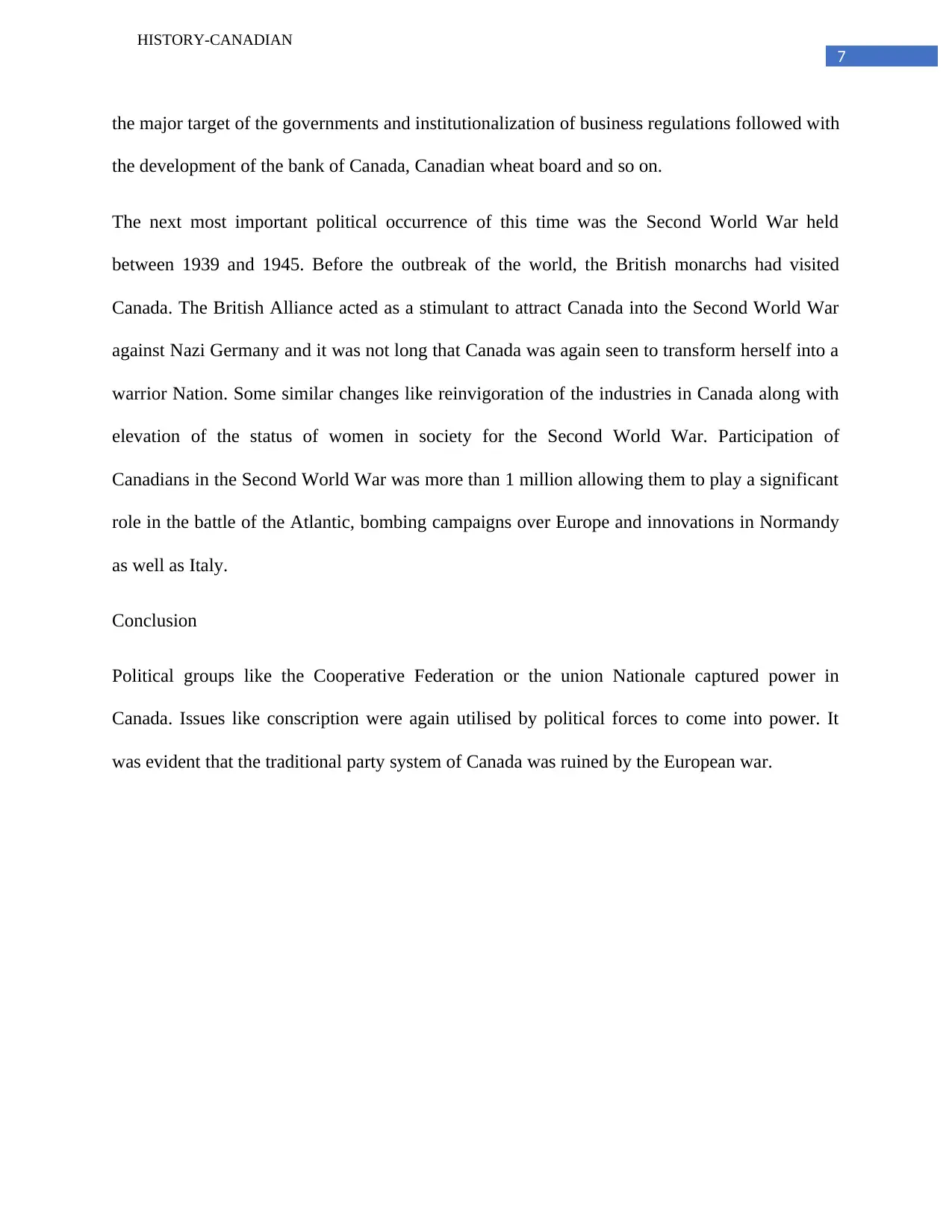
7
HISTORY-CANADIAN
the major target of the governments and institutionalization of business regulations followed with
the development of the bank of Canada, Canadian wheat board and so on.
The next most important political occurrence of this time was the Second World War held
between 1939 and 1945. Before the outbreak of the world, the British monarchs had visited
Canada. The British Alliance acted as a stimulant to attract Canada into the Second World War
against Nazi Germany and it was not long that Canada was again seen to transform herself into a
warrior Nation. Some similar changes like reinvigoration of the industries in Canada along with
elevation of the status of women in society for the Second World War. Participation of
Canadians in the Second World War was more than 1 million allowing them to play a significant
role in the battle of the Atlantic, bombing campaigns over Europe and innovations in Normandy
as well as Italy.
Conclusion
Political groups like the Cooperative Federation or the union Nationale captured power in
Canada. Issues like conscription were again utilised by political forces to come into power. It
was evident that the traditional party system of Canada was ruined by the European war.
HISTORY-CANADIAN
the major target of the governments and institutionalization of business regulations followed with
the development of the bank of Canada, Canadian wheat board and so on.
The next most important political occurrence of this time was the Second World War held
between 1939 and 1945. Before the outbreak of the world, the British monarchs had visited
Canada. The British Alliance acted as a stimulant to attract Canada into the Second World War
against Nazi Germany and it was not long that Canada was again seen to transform herself into a
warrior Nation. Some similar changes like reinvigoration of the industries in Canada along with
elevation of the status of women in society for the Second World War. Participation of
Canadians in the Second World War was more than 1 million allowing them to play a significant
role in the battle of the Atlantic, bombing campaigns over Europe and innovations in Normandy
as well as Italy.
Conclusion
Political groups like the Cooperative Federation or the union Nationale captured power in
Canada. Issues like conscription were again utilised by political forces to come into power. It
was evident that the traditional party system of Canada was ruined by the European war.
Paraphrase This Document
Need a fresh take? Get an instant paraphrase of this document with our AI Paraphraser
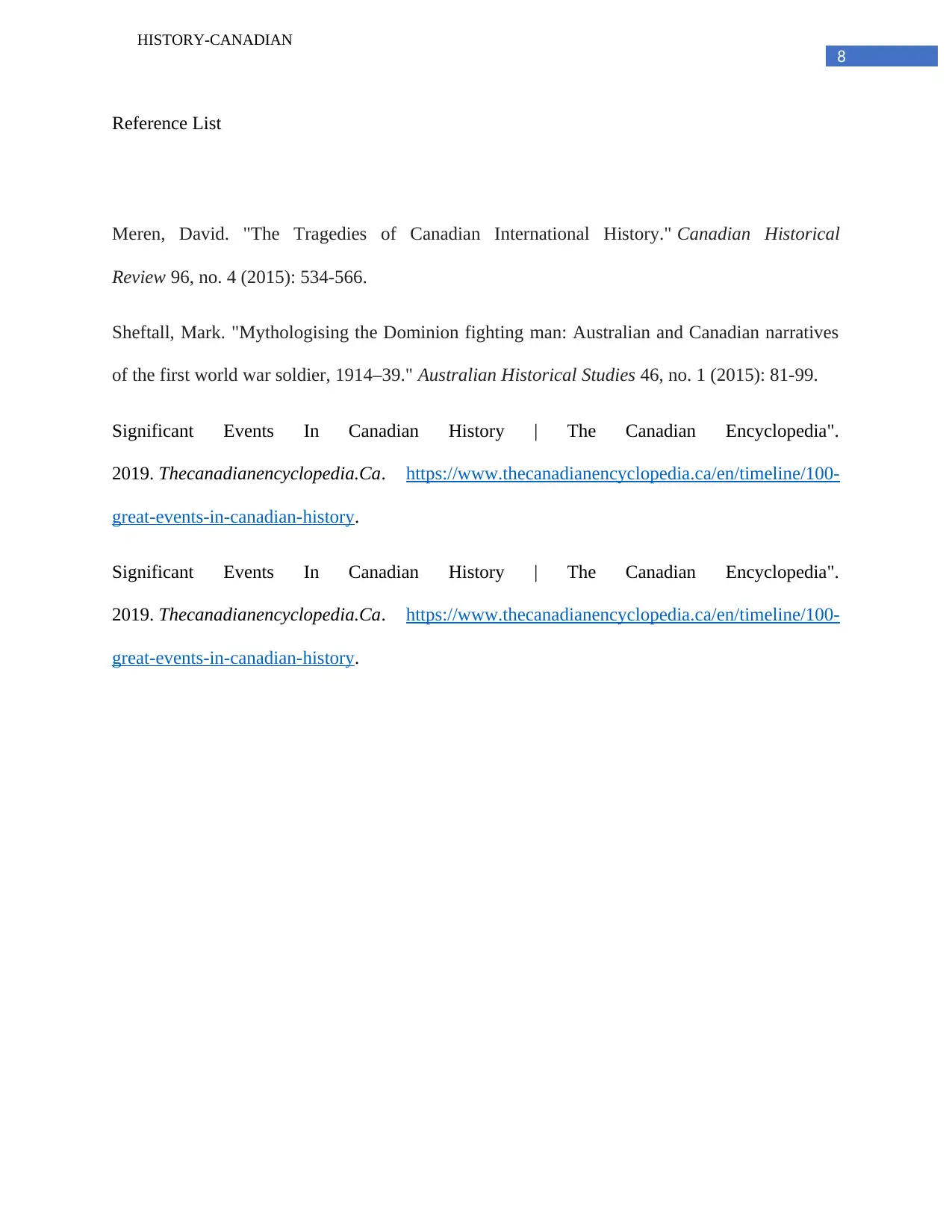
8
HISTORY-CANADIAN
Reference List
Meren, David. "The Tragedies of Canadian International History." Canadian Historical
Review 96, no. 4 (2015): 534-566.
Sheftall, Mark. "Mythologising the Dominion fighting man: Australian and Canadian narratives
of the first world war soldier, 1914–39." Australian Historical Studies 46, no. 1 (2015): 81-99.
Significant Events In Canadian History | The Canadian Encyclopedia".
2019. Thecanadianencyclopedia.Ca. https://www.thecanadianencyclopedia.ca/en/timeline/100-
great-events-in-canadian-history.
Significant Events In Canadian History | The Canadian Encyclopedia".
2019. Thecanadianencyclopedia.Ca. https://www.thecanadianencyclopedia.ca/en/timeline/100-
great-events-in-canadian-history.
HISTORY-CANADIAN
Reference List
Meren, David. "The Tragedies of Canadian International History." Canadian Historical
Review 96, no. 4 (2015): 534-566.
Sheftall, Mark. "Mythologising the Dominion fighting man: Australian and Canadian narratives
of the first world war soldier, 1914–39." Australian Historical Studies 46, no. 1 (2015): 81-99.
Significant Events In Canadian History | The Canadian Encyclopedia".
2019. Thecanadianencyclopedia.Ca. https://www.thecanadianencyclopedia.ca/en/timeline/100-
great-events-in-canadian-history.
Significant Events In Canadian History | The Canadian Encyclopedia".
2019. Thecanadianencyclopedia.Ca. https://www.thecanadianencyclopedia.ca/en/timeline/100-
great-events-in-canadian-history.
1 out of 8
Related Documents
Your All-in-One AI-Powered Toolkit for Academic Success.
+13062052269
info@desklib.com
Available 24*7 on WhatsApp / Email
![[object Object]](/_next/static/media/star-bottom.7253800d.svg)
Unlock your academic potential
Copyright © 2020–2025 A2Z Services. All Rights Reserved. Developed and managed by ZUCOL.





